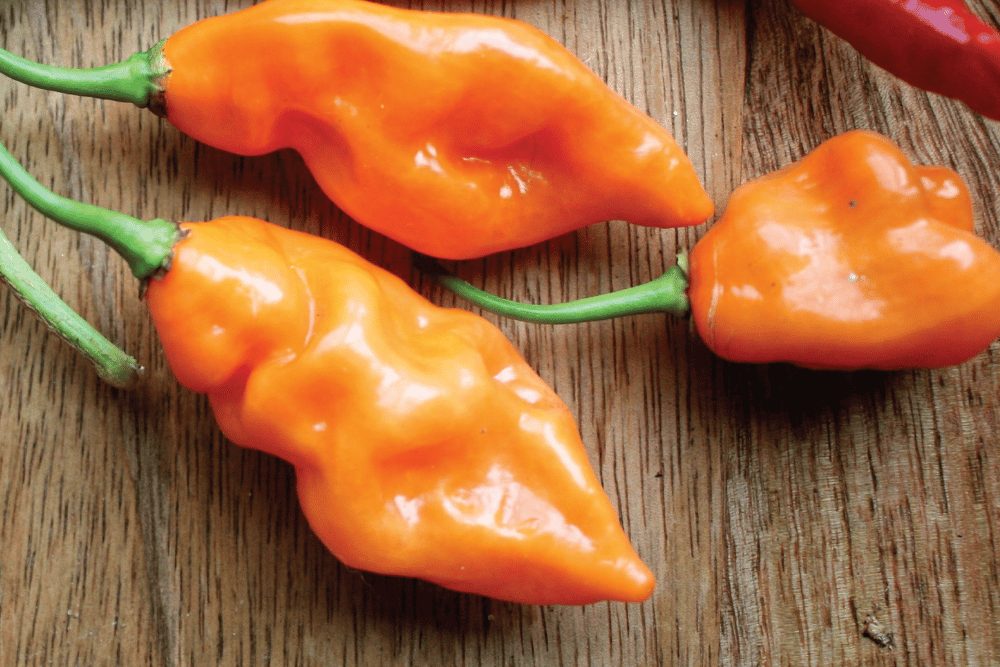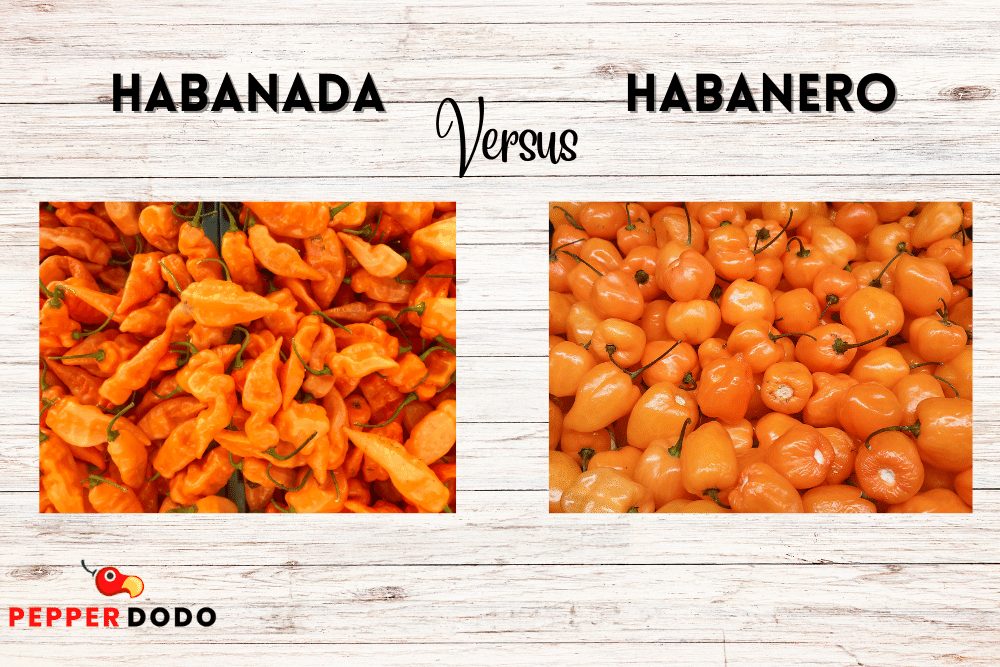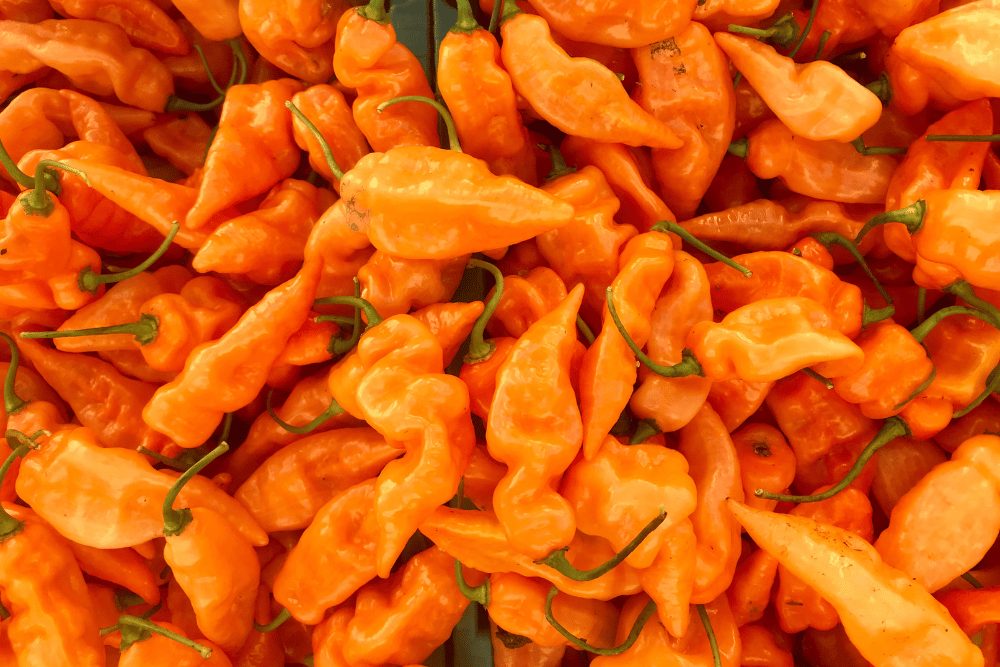The habanada pepper is a relatively new sweet pepper with zero heat. It was developed in America by renowned organic plant breeder Michael Mazourek, and it was not until 2014 that the world learned about Habanada. The distinctive habanero-like floral and fruity flavor and its lack of heat make it a favorite for chefs, farmers, and food lovers worldwide.
What Are Habanada Peppers?
Habanada peppers are a new, non-native chile from capsicum annum species. A senior professor, Michael Mazourek from Cornell University, bred it for thirteen generations to produce a pepper variety that he could comfortably enjoy with his friends who didn’t like hot chiles.
Michael cross-bred the hot habanero with a heatless pepper to create habanada. The name ‘Haba’ is after chile habanero, while ‘Nada’ means zero heat. So, this sweet chile is like a heatless habanero pepper. Other names for chile habanada include Sweet Habanero or Honey Zepper.
Habanada makes you feel like you’re eating the mighty habanero without the burning sensation. It has a similar intense taste making it versatile in any of your favorite soups, salsas, or tacos. Its fruity and floral flavor makes it delicious in classic Caribbean and Latin cuisines, including fruit salsas.
It’s even tasty raw as a crunchy and healthy snack.
Appearance
Although chile habanada is similar to habanero pepper in appearance, it features an elongated, spiraled, and tapered look.

Color
Like most peppers, habanadas have a deep green color before maturing gold and later tangerine-orange when fully ripened. Sometimes, you may find color variations of red sweet habanero peppers.
Size
Mature habanada peppers are usually 2-3 inches long and 1-1.5 inches in diameter. This heatless habanero’s pepper tree reaches just 18 inches tall at maturity.
Sweet habanero texture
Habanadas have a similar texture to habaneros. It features a glossy, tout, smooth texture. Sometimes, it may get a light bumpy feel due to folds and twists.
How Spicy Are Habanada Peppers?
Habanada peppers are the first heatless habanero chiles. They have a rating of 0 (zero) SHUs on the Scoville scale—nada heat. Compared to Habanero pepper (100,000- 350,000 shus), habanada is 350,000 times milder in heat.
Jalapenos (2,500-8,000 SHUs) are 140 times less spicy than a habanero pepper, while poblano pepper carries moderate heat with a range of 1,000-1,500 SHUs.
Another hybrid pepper, nadapeno pepper is the beloved jalapeno minus the heat. So, habanada and nadapeno have the same heat level.
What Do Habanada Peppers Taste Like?
These sweet peppers have an intensely floral, melon-like, honeydew flavor with a tropical twist.
Like the habanero, this pepper retains the tangy, floral taste combined with a slight earthiness that makes it excellent for any cuisine.
Habanada Peppers vs. Habanero Peppers
With habanero pepper as the parent chile, these two chilies share distinct similarities and differences:
- SHU: Habanero is a hot pepper ranging between 100,000-350,000 SHUs on the Scoville scale. Conversely, Habanada has no heat, 0 (Zero) SHU.
- Size: The sweet habanero is 2-3inches long and 1-1.5 inches wide. On the other hand, your standard habanero is shorter (1-2 inches).
- Shape: Habanada chile has an elongated, curvy, spiraled body with a tipped end, while habanero’s pod is shorter and may appear ‘squashed.’
- Color: Habanada peppers start with green and turn orange when they mature. In contrast, habaneros turn from green to different color variations when ripe, including red, orange, white, brown, yellow, or purple.
- Taste: While both peppers have a shared fruity, floral flavor, habanada is sweeter, less fruity, and less aromatic than habanero chiles.
- Texture: The habanada has smooth skin, which may feel bumpy due to its wavy shape. In contrast, habanero feels soft and more satiny.
- Species: Habanada belongs to the Capsicum annuum class, while habanero is a member of the Capsicum chinense species.
- Uses: Due to its extreme heat, habanero is best for making hot sauces, authentic soups, salsas, and stews. Habanada pepper goes well with any cuisine requiring little or no heat, including sweet sauces.

How To Use Habanada Sweet Peppers
The sweet habanero is a versatile pepper. It is used to flavor different dishes as follows:
- A healthy snack – Eat raw habanada chili or sprinkle it with salt and your favorite seasoning to enjoy it as a healthy treat.
- Roasting grilling or braising – For a deep, intense flavor, you can roast, grill, or braise your habanada pepper and serve it with your favorite stew.
- For stuffed foods/dishes- Stuff your meats, grains, or cheese into your habanada pepper. Take caution to avoid over-stuffing since the peppers are thin-walled.
- Serve with fresh ceviche – Use chopped habanada chile in fresh ceviche instead of red bell peppers.
- Pico de Gallo – Use habanada pepper instead of habanero for a sweeter, fruity, smoky pico de gallo that’s mild in heat and gentle on your taste buds.
- Flavoring fresh vegetable salads – Include thinly sliced sweet habanero slices into your fresh veggie salad for a delicious treat.
- For pickled recipes – Make pickled habanada peppers and store them for everyday use in your favorite dishes.
- Sweet sauces – Habanada chile is perfect for sweet chili sauces, pepper jelly, and other sweet pepper recipes.
- Flavoring roasted/fried meats, including beef, pork, chicken, or seafood – The chile provides a profoundly fruity, floral flavor of habanero into your meaty dishes without burning your mouth.
- Cocktails – Put habanada slices into your cocktail for a delicious honeydew-like flavor.
Where To Buy Habanadas
The easiest way to get Habanadas is by growing them in your backyard. Pepper seeds/plants are available in online stores, including Walmart and Amazon. If you’re lucky, you may buy habandas locally at your farmers’ market or specialty Latin market.
Can You Grow Habanada Peppers?
Yes! Habanada peppers are easy to grow in many climates. The pepper plants need ample sunlight, water, and heat for germination. Since it is hybrid/open-pollinated (stable variety), you can store your seeds for future use.
Habanada peppers were developed to be disease-resistant. Germination takes place within 14-28 days, and after 70/90 days, your chiles will be fully mature. It’s best to apply nitrogen from compost manure before the first fruit and gradually reduce it towards maturity.
Substitutes For Habanada Peppers
You can use the below peppers if you can’t find habanada peppers:
- Habanero pepper – If you are looking for habanada’s flavor and don’t mind a heat upgrade, habanero is an excellent substitute.
- Aji dulce pepper – This habanero look-alike has mild heat (0-1,000 SHUs) and a tropical flavor similar to habanada.
- Tangerine dream pepper (0-100 Scoville heat units) – This chile also has very mild heat, similar color, and a sweet taste, great for summer salads and authentic sweet sauces.

